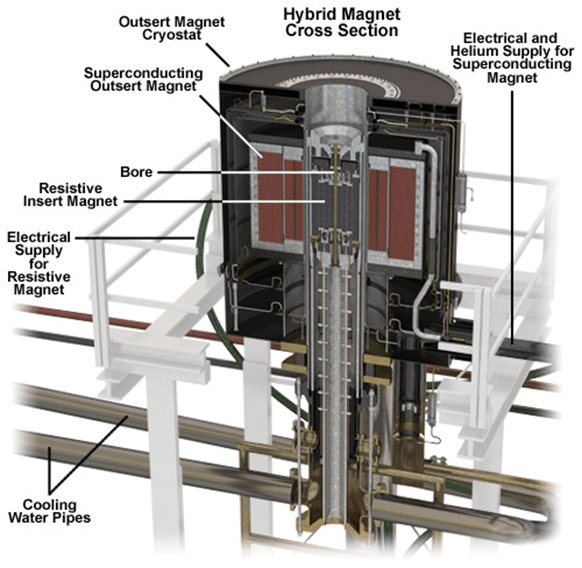

In 2010, Andre Geim and Konstantin Novoselov won the Nobel prize in Physics for their research on graphene - a 2D crystalline structure consisting of a single atomic layer of carbon. In their research, they discovered remarkable mechanical and electrical properties - it's substantially stronger than steel but also very stretchable, has extremely high thermal and electrical conductivity, and, as they discovered when studying graphene under a high magnetic field, it exhibits an unusual fractional quantum Hall effect and exotic type of tunneling. [1]
Like the research on graphene which won Gein and Novoselov the Nobel prize in Physics, much of the world's most ground-breaking research would not be possible without high magnetic field laboratories.
The success of research in materials science, chemistry, biology, and physics under high magnetic fields have major impacts on health care and technology. High magnetic fields are also used in particle accelerators like at CERN’s Large Hadron Collider (LHC).
Together with the magnet laboratories in Grenoble, Dresden, and Toulouse, the High Field Magnet Laboratory at the Radboud University in Nijmegen forms part of the European Magnetic Field Laboratory. There are only a few laboratories in the world where high magnetic field research can be performed.
For perspective, the Earth's magnetic field is on the order of 30-60 microteslas - so this magnetic field will be 106 times stronger than the magnetic field protecting us from solar wind. A typical MRI magnet is about 2 or 3 Teslas.
Since nothing quite like this magnet exists yet, the magnet has to be built from scratch, involving experts from around the world in a variety of disciplines. This new 45 Tesla hybrid magnet requires a lot of equipment to keep it running and to make sure that it is operating safely. If something goes wrong in its operation, the magnet can break - a mistake that will cost around 10 million Euros.
The magnet being developed at the High Field Magnet Laboratory is a hybrid magnet consisting of an inner resistive electromagnet which produces a magnetic field of just over 32.8T and an outer superconducting magnet that produces 12.3T. The inner resistive magnet is operated at 40kA. The outer superconducting magnet is operated at 20kA.

The two magnets are run together to produce a combined magnetic field strength of around 45T. This enormous amount of current creates some incredibly demanding power requirements – not just for the current to produce the magnetic field but also for the cooling system to keep the magnet operational.
For a superconductor to be a superconductor, the material needs to be held at extremely low temperatures - close to 4 K (-269 C). Under proper conditions the material will operate as a superconductor, so the current is able to flow freely without resistance (R=0), meaning that the voltage across the superconductor is zero (Ohm’s law states that V=IR so V=I*0=0). The reality of a superconductor is that thermal expansion and mechanical changes, imperfections in the conductive material, transients, cooling system faults, and even radiation can generate some heat energy which can locally raise temperatures in the material above the point where it is able to be in the superconducting state (V=0), bringing the material into the normally conducting state(V!=0). When the material goes from the superconducting state to the conducting state the dissipated power goes from IV=0 to IV!=0 which will dissipate as heat energy in the surrounding atoms, causing the local temperature rise to spread at an exponential rate.
This runaway process quickly leads to temperatures causing irreparable damage to a system that costs 100 Million Euro. This phenomenon is called a "quench” and is a normal part of the operation of a superconducting electromagnet – making quench detection systems essential.
Quench detection systems monitor those very small voltage changes in various zones of the superconducting material. When an abnormal change in voltage is detected it triggers a security system to quickly shut off the power and prevent the quench from spreading and irreparably damaging the system.
To do this, VI Technologies chose to use a National Instruments cRIO 9049 with onboard FPGA. The FPGA is used to measure the voltage at various points on the superconducting coil. There is a relatively low signal-to-noise ratio, so some filtering is necessary to accurately detect voltages that indicate a quench. This aspect of the software is still being designed since the magnet is still in development. As a result, the FPGA software needs to be designed in a modular way to be able to flexibly change the filtering and parameters for the quench detection algorithm.
“Using an FPGA adds flexibility, because instead of needing to design a whole PCB around the detection circuit and reprint every time we have to change the filtering, we can just change some code and the detection circuit hardware is automatically changed with it – that’s the beauty of working with an FPGA” says software system designer Roger Custers from VI Technologies.
Since the algorithm is operating directly in hardware the quench detection FPGA can trigger circuit breakers to shut down the flow of current to the superconductor and cut the quench off at the source in just 100 microseconds.
This magnet is still under construction and scheduled to be fully commissioned end of 2021, so the precise quench detection is still being tuned. VI Technologies has used LabVIEW and SystemLink to create the software including the FPGA code with the option of using simulated data so that the scientists and engineers at HFML can use the data previously recorded on the system in place of the voltage signals on the machine to simulate conditions that occurred in the lab. Being able to use simulated hardware components to test the full range of software components involved including the FPGA enables fine-tuning of the precise quench detection algorithms. It also enables the team at HFML to replay situations that occurred in the lab during development to look closely at what happened and how the FPGA should respond.